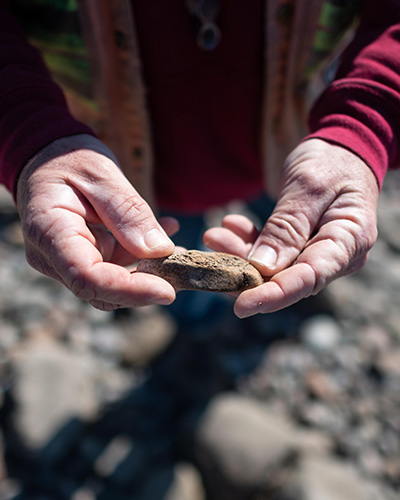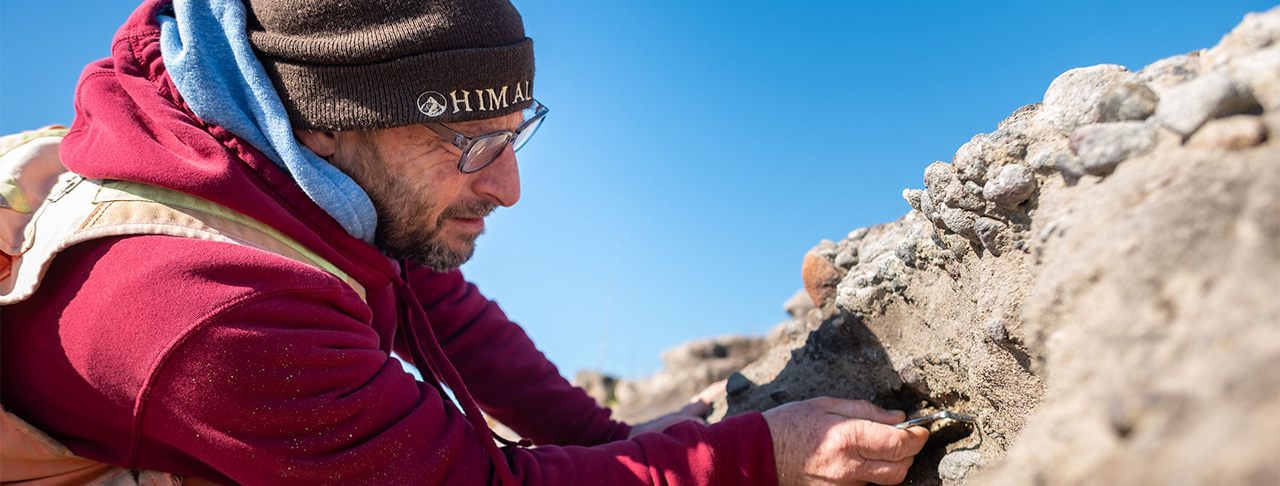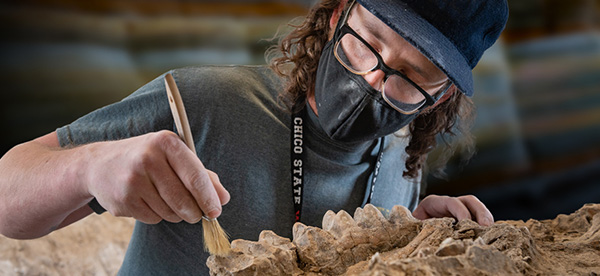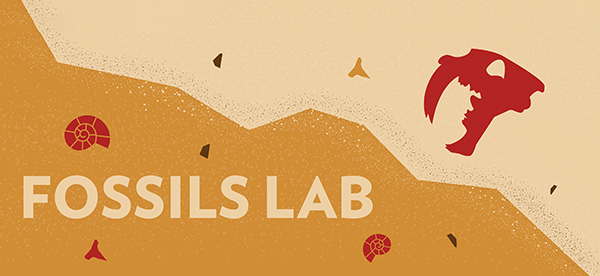Chico State Miocene Fossil Finds
In 2020, fossils from the Miocene period dating back 8 to 15 million years were discovered in the foothills south of Sacramento. The ongoing excavation of the site is being led by Professor Russell Shapiro, a nationally recognized expert in geobiology and paleontology.
Contact Information
- Fossil Questions: rsshapiro@csuchico.edu
- Museum Questions: gateway@csuchico.edu
- Program Questions: erth@csuchico.edu
What was found?
Miocene fossils
- 8-million-year-old mastodon skull with both tusks intact
- a rhino skeleton
- a giant tortoise
- 600 petrified trees
- a horse
- a tapir
- an extinct species of camel that was as tall as a giraffe
- four tusks from gomphotheres (elephant-like proboscideans)
- and too many others to list here!

Where was it found?
An undisclosed location in the Sierra Nevada foothills south of Sacramento, in the Mokelumne River watershed. The fossil site now spans more than 12 miles and hundreds of acres.
Who found it?
An East Bay Municipal Utility District (EBMUD) park ranger made the initial discovery, finding petrified trees and vertebrate fossils. Russell Shapiro, Todd Greene, and others from Chico State led the excavation of the site, which resulted in the discovery of hundreds of significant fossils.
The team also consists of researchers from the University of California, Davis, and Sierra College, including Chico State alumnus Dick Hilton ('75), a national authority on dinosaurs and vertebrate paleontology.
Why is the find significant?
The site is considered to be one of the most significant fossil discoveries in California history. In addition to the sheer quantity of fossils, the variety of species is noteworthy. Additionally, mastodon remains were last found in the state in 1947.
The bones paint a clearer picture of life 10 million years ago when animals evolved from living in forests to grassland as the landscape changed.
How is the find tied to the University?
Professors, staff, and students from the Earth and Environmental Sciences Department at Chico State led the excavation of the site and are processing and preserving the fossils that have been found. A public exhibit of the fossils has been at the University's Gateway Science Museum from fall 2021 through spring 2023.
Chico State is one of only a few universities in Northern California that is federally sanctioned to collect and store fossils.
Students can help prepare the fossils that will eventually be sent to the University of California Museum of Paleontology or used at the new museum exhibit.
“We have more projects than we know what to do with,” Shapiro said. “There are lots of opportunities for new students.”
Shapiro, department chair and sedimentology professor Todd Greene, several staff members, and a handful of students continue to make regular treks to the site, usually discovering at least one fossil.
What’s Next?
Many of these fossils are being studied at Gateway Science Museum and are on public display in the Fossils Lab.
The exhibition, Fossils & Formations, opened October 22, 2021 through June 2023 featured these Miocene fossils. The exhibit traced the complex geological past of the North State from the deep sea creatures of the Triassic to the megafauna of the Pliocene.
To learn more about the exhibit, sign up for Gateway’s newsletter(opens in new window).
Relevant Degrees and Classes
Degrees
Classes
ERTH 643 Applied Paleontology
Prerequisites: ERTH 303, ERTH 307
This course trains students in the fundamentals of paleontological resource management. As an applied course, students integrate governmental regulations with the scientific method and client budgetary demands.
A significant objective is to provide students with the practical experience to be able to apply for work as a "Paleontological Monitor" during environmental impact studies. This course makes extensive use of bibliographic and other resource materials.
Media Links
- Chico State Today: Unearthing California’s Prehistoric Past. May 17, 2021.
- North State Public Radio: A REAL-LIFE INDIANA JONES: A Conversation With Professor Russell Shapiro. May 28, 2021.
- East Bay Municipal Utility District: Mastodons Among Us. June 11, 2021.
- San Francisco Chronicle: 'I was looking at the bones of great beasts': Astounding discovery made in Calif. valley. May 21, 2021.
- Smithsonian: Park Ranger Stumbles Upon Treasure Trove of Several-Million-Year-Old Fossils in Northern California. May 24, 2021.
- The Guardian: How a ranger stumbled upon one of the largest fossil finds in California history. May 26, 2021.
- Gizmodo: Giant Camels and More Treasures Discovered in Fossilized California Forest. May 25, 2021.
- CapRadio: Treasure Trove of Fossils Found in Sierra Nevada Foothills. May 30, 2021.
- Business Insider: One of the biggest fossil finds in California history has revealed ancient elephants, camels, and bone-crushing dogs. May 29, 2021.
- The Washington Post: ‘Giant treasure trove’ of fossils may give a better picture of Miocene epoch about 10 million years ago. May 30, 2021.
- The Weather Channel: Utility Worker Stumbles on Major Fossil Find. June 9, 2021.
- Big Think: Massive fossil find in California includes mastodon, petrified forest. June 1, 2021.
- LiveScience: Forest ranger stumbles onto garden of ancient beasts in California foothills. May 23, 2021.
- Ancient Origins: California Park Ranger Discovers Massive Cache of Miocene Epoch Fossils. May 23, 2021
- Union Democrat: Fossils of mastodon, other ancient mammals millions of years old discovered near Valley Springs. May 21, 2021.
- CBS SF BayArea: ‘Bones of Great Beasts;’ Hundreds of Prehistoric Fossils Discovered in EBMUD’s Mokelumne River Watershed. May 18, 2021.
- CBS Sacramento: Trove Of Fossils Discovered In Mokelumne River Watershed Near Valley Springs. May 18, 2021.
- ABC10: Geologic treasure trove of fossils discovered in Mokelumne River Watershed. May 19, 2021.
- KCRA: Scientists study mastodon fossils found in Mokelumne River Watershed. May 21, 221.



